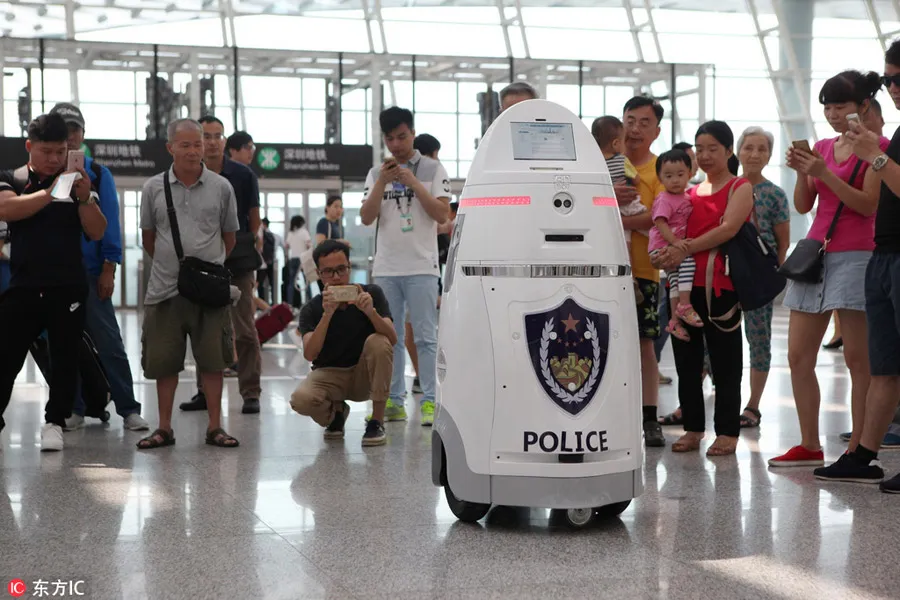
'Robo-cop' patrols Chinese airport
Oct 02, 2016

In a bid to enhance security and efficiency, a Chinese airport has deployed Robo-cop patrols, integrating advanced robotics into its monitoring strategy. These robotic units are equipped with cutting-edge technology, including facial recognition and real-time surveillance capabilities, allowing them to identify potential threats and assist passengers. With their ability to navigate crowded spaces autonomously, Robo-cops provide a unique presence, blending modern innovation with traditional security measures. Their introduction aims to reduce human workload while increasing safety, offering travelers a futuristic experience at the airport. This initiative reflects China's commitment to leveraging technology in public safety and transportation.
The integration of advanced technology into everyday life continues to evolve, with "RoboCop" patrols emerging as a significant innovation, especially in the realm of security. In recent years, Chinese airports have adopted these high-tech guardians to enhance safety and efficiency. Equipped with state-of-the-art features, these robotic patrols are redefining the airport security landscape.
Features of RoboCop Patrols
"RoboCop" units come equipped with a variety of features designed to assist human security personnel while providing travelers with a sense of safety. Some key features include:
| Feature | Description |
|---|---|
| Autonomous Navigation | RoboCop units can navigate through airport terminals autonomously, avoiding obstacles and efficiently patrolling designated areas. |
| Facial Recognition | Equipped with advanced facial recognition technology, these robots can identify individuals and flag any suspicious activity to human officers. |
| Real-time Data Processing | RoboCops analyze data in real-time, allowing them to respond quickly to potential threats or emergencies. |
| Communication Systems | These robots can communicate with passengers, providing information and assistance while also alerting human staff if necessary. |
Benefits of RoboCop Patrols
The deployment of "RoboCop" patrols in Chinese airports introduces numerous advantages:
- Enhanced Security: By operating continuously, these robots can monitor areas that may be less accessible to human officers.
- Cost-Effectiveness: Although initial investment costs are high, the long-term savings in personnel costs make RoboCops a financially viable option.
- Increased Efficiency: With robots handling routine monitoring tasks, human security staff can focus on more complex security issues.
Challenges and Considerations
While the introduction of "RoboCop" patrols presents many benefits, several challenges must be addressed:
- Technical Limitations: RoboCops rely on technology that can malfunction or become outdated, requiring ongoing maintenance and updates.
- Public Acceptance: The effectiveness of these robots relies on public trust. Ensuring passengers feel comfortable interacting with technology is essential.
- Privacy Concerns: The use of facial recognition and data collection raises questions about privacy and data security that must be addressed transparently.
Implementation in Chinese Airports
In China, airports like Beijing Capital International Airport and Shanghai Pudong International Airport have already implemented "RoboCop" patrols, showcasing the potential of this technology. These innovative robots are not just tools for security; they act as ambassadors of technology, demonstrating China's commitment to incorporating cutting-edge solutions in public spaces.
Future Prospects
The future of "RoboCop" patrols in airports looks promising. As technology continues to advance, we can expect the following developments:
- Integration with AI: Future models may incorporate artificial intelligence to learn and adapt to new security challenges, improving their response capabilities.
- Expansion to Other Venues: Beyond airports, we may see "RoboCop" patrols deployed in shopping malls, train stations, and other public spaces, enhancing overall security.
- Collaboration with Human Staff: The synergy between robots and human security personnel will likely evolve, with both working together to create safer environments.
Conclusion
The advent of "RoboCop" patrols in Chinese airports marks a significant step toward a future where technology and security blend seamlessly. As these robots become more prevalent, they represent not only a technological advancement but also a transformation in how we perceive safety in public spaces. The ongoing development of these systems will undoubtedly influence airport security strategies worldwide, paving the way for a new era in travel safety.
In summary, the use of "RoboCop" patrols in airports highlights the possibilities of integrating technology into everyday life, enhancing security, and providing a more efficient travel experience for passengers. As more airports consider adopting this technology, the potential for improved safety and efficiency in air travel continues to grow.
Related Articles

Explore Thailand: The Best Islands to Visit for Paradise, Adventure, and Relaxation

The Ultimate Guide to the Best Islands in Thailand for Your Next Getaway

Do babies need passports? How to get a passport for a newborn

How to get a U.S. passport fast: here’s how to expedite the process

What is Mobile Passport Control: 5 reasons why you should use it

SENTRI vs. Global Entry: A detailed guide

Do you need a passport to go to the Bahamas? Let’s find out

Do you need a passport to go to Mexico? A detailed guide

Do you need a passport to go to Canada? We got the answer

Do You Need a Passport for a Cruise: An Essential Travel Guide

Booster Seat Requirements: All the Rules to Follow in Your Rental Car

What Are the World’s Most Powerful Passports, and How Does Yours Rank?

How to Take a Passport Photo at Home: A Helpful Guide

You've got to have heart! Southwest's new livery

Your opinion: Should water be free on low cost carriers?

Young women bolder than guys as solo travellers
